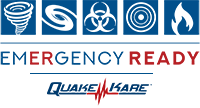Earthquake Risk Reduction
Earthquake Risk Reduction for the Home
Individuals who reside in earthquake prone areas are advised by experts to “drop, cover, and hold on” if they are inside during an earthquake. This is because we are not as likely to see total structural failure as in other countries. Our wood frame homes generally do very well in earthquakes and strict building codes reduce the risk of structural failure in our modern (post 1933) masonry buildings. Our greatest risk of injury during an earthquake comes from nonstructural hazards such as falling decorative pieces, fixtures, and heavy furniture. Nonstructural hazard mitigation is one of the least expensive ways to decrease the incidence of injury. Please follow the below list to identify and mitigate potential hazards in your home, office or classroom.
Secure your hot water heater
Secure household items and furniture
Check chimneys, roofs and wall foundations for stability. Note: If your home was built before 1935, make sure your house is bolted to its foundation. If your home is on a raised foundation, make sure the cripple walls have been made into shear walls. Call a licensed contractor if you have any questions.
Keep breakable and heavy objects on lower shelves. Put latches on cabinet doors to keep them closed during shaking.
Fasten shelves securely to walls.
Place large or heavy objects on lower shelves.
Store breakable items such as bottled foods, glass, and china in low, closed cabinets with latches.
Hang heavy items such as pictures and mirrors away from beds, couches, and anywhere people sit.
Brace overhead light fixtures.
Repair defective wiring and leaky gas connections which are potential fire risks.
Repair any deep cracks in ceilings or foundations. Get expert advice if there are signs of structural defects.
Install an Automatic Gas Shut Off
Earthquake Risk Reduction at Work
Your workplace has the legal obligation to ensure that the work environment is free of hazards to employees. This includes items that may become dangerous during the seismic activities of earthquakes. Office buildings are known to shake and shift drastically during an earthquake turning everyday work equipment into deadly hazards. Please follow the below earthquake risk reduction list to identify and mitigate potential hazards in your workplace.EQUIPMENT AND FURNISHINGS: Strap rows of multiple file cabinets, mainframes, bookcases, etc., together. High racks should be secured together on top and to the floor on the bottom. Secure desktop computers, typewriters. Keep computer CPUs on the floor next to their workstations. Secure cabinet doors with positive latches.
Store hazardous materials correctly and educate all your employees about them. Secure freestanding, moveable partitions. A good rule of thumb is to secure anything above desktop level.OVERHEAD: Seen and unseen objects overhead and above suspended ceilings may pose hazards to workers below. Secure all objects that are above desktop level. Check for diagonal bracing wires suspended in ceilings. Ensure proper restraint of "stem" light fixtures and fluorescent light panels. Securely attach decorative ceiling panels, spotlights, speakers, air conditioning units, etc.
Check above suspended ceilings for poorly attached ducts, cables, etc.ELECTRICAL EQUIPMENT: Shock hazards exist if unsecured electrical equipment breaks its connection or exposes energized lines. Unsecured equipment may short out the power in your office building. Secure any electrically powered equipment. Have back-up power generator for emergency lighting and to protect computer against data loss. Insure that generators, their fuel tanks, battery packs, and fuel lines are properly secured. Secure emergency lighting: Secure telecommunication equipment, switches, and control boxes.
PLANT EQUIPMENT: Loss of plant equipment may prevent you from continuing your business after a quake. Secure water heaters, furnaces, boilers, fans, pumps, heating, ventilating, air conditioning equipment, and the ducting or pipes that go with them.
HAZARDOUS MATERIALS: Unsecured or improperly stored hazardous chemicals may force your business out of an otherwise undamaged building. Secure large containers of production chemicals or cleaning supplies. Ensure that all toxic items are in the correct container and properly labeled. Ensure that all employees know what to do in case of a spill. Keep all large containers or vats of toxic, hot, or hazardous items covered to prevent surging in an earthquake.
EMPLOYEES: Establish an education and awareness program for work and home. Encourage family involvement. Encourage employees to be prepared at home and at work. Give each employee specific instruction regarding hazards, safety warnings, emergency plans and supplies.
NEIGHBORS: Find out what your neighbors do. Their enterprise may put your business in jeopardy. You may need to plan for problems related to their potential problems.
